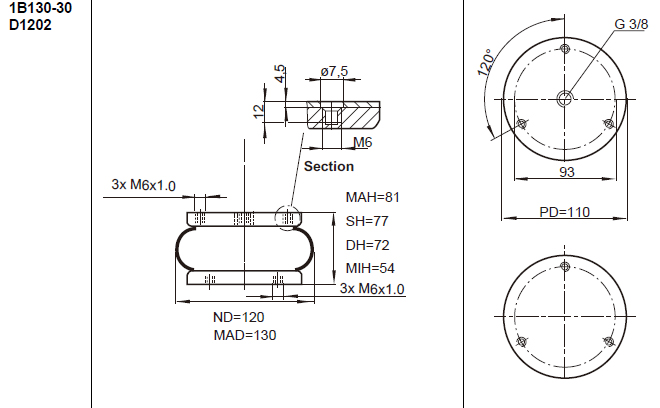
Shortcode description
MAH: Maximum Height. It refers to the maximum height value that the air spring can reach without the airbag bursting under the condition that the air spring is restrained at both ends;
SH: Safe Height. It refers to the maximum height value that has been rigorously tested by the technicians of Fryce Corporation and considered to be long-term and safe. It is recommended not to exceed this height value during use. If you need to use more than this height value, please consult technicians of Fulies;
DH: Design Height. In consideration of lateral stability, we recommend that air springs be used at a specified height when used as a vibration isolator. This specific height is called the “isolated design height”, or design height for short. When using the air spring as a vibration isolator, you can refer to this height value. When used as a driver, the design height can be ignored;
MIH: Minimum Height. The minimum height to which the air spring can be compressed. When compressing an air spring, keep the height of the air spring slightly higher than the specified minimum height. If the airbag is in a compressed state for a long time, it may cause damage. Therefore, a downward limit is required to prevent this situation. The outer lower limit can be a simple steel block, and the limit height should be slightly higher than the minimum height of the air spring. If the external lower limit cannot be used, Fulies can also provide air springs with built-in rubber cushions;
MAS: Maximum Stroke. The Maximum Stroke (MAS) is the difference between the maximum height (MAH) minus the minimum height (MIH), which is MAS = MAH-MIH.
SS: Safe Stroke. The Safe Stroke (SS) is the difference between the safe height (SH) minus the minimum height (MIH), which is SS = SH-MIH.
ND: Natural Diameter. Refers to the maximum diameter of the air spring in the natural state of the air spring before leaving the factory, unconstrained and uninflated. This value is for reference only. The outer diameter of the air spring will change according to the external pressure and internal pressure.
MAD (or Max. Φ): Maximum Diameter. It refers to the maximum outer diameter that the airbag can reach within the range of allowed height, vibration isolation force, driving output force and internal pressure. For equipment with limited installation space, this parameter value is very important;
PD: Plate Diameter. Refers to the outer diameter of the metal plates at the upper and lower ends of the bladder air spring.
ED: End Diameter. It refers to the outer diameter of the rubber capsule body of the bladder air spring.
Explain the glossary
Lateral stiffness: Lateral stiffness refers to the ability to resist lateral deformation. It is the ratio of the horizontal force applied to the structure to the horizontal displacement caused by it. Its size is not only related to the nature of the material itself, but also to the cross-section and shape of the component or structure. In simple terms, it is the reciprocal of the displacement caused by applying a force of unit 1, which can be calculated using graph multiplication. The single-capacity and double-capacity air springs without additional air storage chambers at the design height generally have a rigidity rule of: lateral stiffness is 1/5 to 1/2 of vertical stiffness (Only the lateral stiffness of the larger high-strength airbag will be 1/2 of the vertical stiffness) . Single- and double-bladder air springs should be used at their design height, because air springs have maximum lateral stiffness or stability at this height. As the height of the air spring decreases, its lateral stiffness also decreases.
The media of using air springs
Air springs are designed for use with compressed air. Nitrogen is also acceptable. Air springs may be filled with water or water-glycol (automotive antifreeze) solutions. If water is to be used, rust inhibitors should be added to protect the end closures.
Two reasons for liquid filling an air spring are:
- To reduce the internal volume of air (and therefore, increase the natural frequency of the air spring) .
- To use a media which is incompressible. Accurate positioning would be one reason to do this.
Petroleum base fluids (most hydraulic oils fall into this category) are NOT RECOMMENDED.
Moderately lubricated air will not harm the bellows.